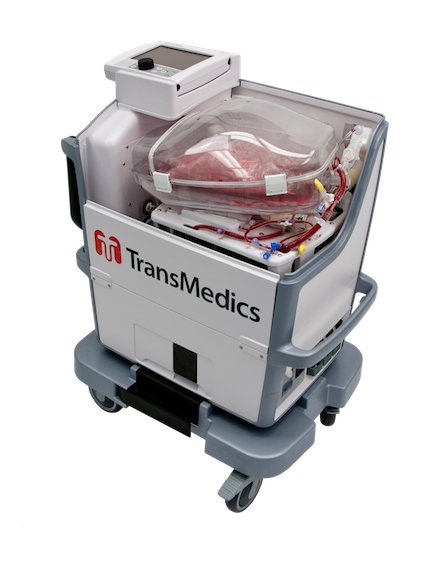
At a Glance
- TransMedics Organ Care System is a warm blood perfusion and monitoring system
- OCS Lung gained FDA approval for standard bilateral lung transplantation
- UVA is now utilizing the OCS Lung for FDA-approved indications and others through clinical trials
- UVA is also part of a study examining the use of the OCS Liver machine to rehabilitate donor livers
Procuring healthy organs for transplant is like stirring up the perfect storm; there are so many components, so many variables that must align at just the right time and place to ensure a successful outcome. Recent advances in technology, however, are giving transplant surgeons greater control over some aspects of this process that have proven limiting in the past.
The TransMedics® Organ Care System (OCS™) is one of the devices changing the procurement process. This portable warm blood perfusion and monitoring system gained FDA approval last spring for standard bilateral lung transplantation procedures after promising results from the INSPIRE Trial, which were published in the peer-reviewed journal The Lancet Respiratory Medicine.
According to the published study results, the OCS Lung System proved “safe and effective compared to the current cold storage standard of care for the preservation of standard criteria donor lungs.” In addition, there were other benefits of the device, including a significant reduction in Primary Graft Dysfunction Grade 3 (PGD3).
“Primary graft dysfunction occurs in approximately one-third of transplant patients,” says Alexander Krupnick, MD, surgical director of lung transplant at UVA. “This can be very traumatic and can lead to large number of deaths. It’s a problem for all organs, but even more so for lungs.
“With the current standard of care, we get a donor organ, flush it with a special solution that decreases metabolism and cools it down. We then put the organ on ice and transport it,” explains Krupnick. “This process — going from warm to cold, starving those cells of oxygen over a long period and then suddenly restoring blood flow — increases the risk of injury.”
The OCS Difference
The OCS device eliminates the abrupt warm-to-cold transition, instead keeping organs in their physiologic state. “We take the organ out and put it on the OCS machine, which perfuses the organ with warm blood, essentially keeping it alive,” says Krupnick. “When the organ is put into the patient, it’s warm, functioning normally and is healthy.”
Compared to the kidneys or liver, lungs are particularly vulnerable to injury or infection. In fact, only around 1 in 5 lungs from deceased donors is viable for transplant. Previous ex-vivo lung perfusion (EVLP) devices have helped improve these odds, but the OCS Lung is the first portable perfusion system.
“We have a rapidly growing and aggressive lung transplant program, so we go great distances to acquire lungs,” says Krupnick. “If we’re going to the West Coast, the flight itself can be six hours. With this portable device, we can put lungs on the machine right away rather than putting them on ice and having six to eight hours of cold ischemic time while we’re traveling back to UVA. In transit inside the OCS, lungs are not only kept warm, they are also monitored and ventilated so they can continue to breathe and stay healthier.”
Because of its proven success and preliminary FDA approval, additional studies are now under way to determine additional applications for the OCS machine. These include investigating concrete indications for older lungs from donors over age 55 and utilizing lungs from unique and extended condition donors. “These are organs most programs are reluctant to take, but Transmedics allows you to rehabilitate the organs,” says Krupnick.
Warm Reperfusion for Healthier Livers
Like the lung machine, the OCS Liver device is also being used to rehabilitate much-needed organs. “The goal of the TransMedics device is to not just preserve the liver so that we can transfer it from one place to the other. It’s to resuscitate it, to make it better,” says Shawn Pelletier, MD, surgical director of liver transplantation. “We’re now able to take livers that in the past may not have been usable, but when we put them in the machine and pump them with blood, we improve the quality of the organ and we are able to do the transplant. This is making liver transplant available to more patients.”
UVA is one of 20 transplant centers in the U.S. participating in the OCS Liver PROTECT trial, the first multi-center, randomized clinical trial in the U.S. for warm liver perfusion for transplantation. “We are committed to using all different types of technology to try to find ways to help people on the waiting get better access to a liver and to do it safely,” says Pelletier.
To refer a patient to UVA, call UVA Physician Direct at 800.552.3723.